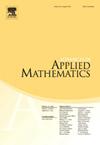Fq[[T]]d中的格和螺旋移位算子
IF 1.3
3区 数学
Q3 MATHEMATICS, APPLIED
引用次数: 0
摘要
研究了一类分类Fq[[T]]d有限指标子模的Hermite范式的代数和组合。我们将这两种范式看作是Gröbner基理论在不同单阶下的实例,其中Hermite范式对应于lex阶,而新范式对应于hlex阶。我们注意到hlex范式恢复了Smith范式,这是Hermite范式所不具有的特征。我们还确定了由六边形范式诱导的细胞分解的组合结构,这似乎是独立的兴趣。值得注意的是,在某种程度上,跟踪单元尺寸的统计量与Nd上的d个“螺旋移位算子”的集合是兼容的,它们成对地交换并共同自由地传递。利用这些算子,我们直接证明了将Solomon[26]和Petrogradsky[25]的结果转化为六次方正规形式所得到的一些新的组合恒等式。本文章由计算机程序翻译,如有差异,请以英文原文为准。
Lattices in Fq[[T]]d and spiral shifting operators
We investigate the algebra and combinatorics of an analogue of the Hermite normal form that classifies finite-index submodules of . We identity both normal forms as instances of Gröbner basis theory under different monomial orders, where the Hermite normal form corresponds to the lex order, and the new normal form the hlex order. We note that the hlex normal form recovers the Smith normal form, a feature not enjoyed by the Hermite normal form. We also identify the combinatorial structure underlying the cell decomposition induced by the hlex normal form, which appears to be of independent interest. Notably, the statistics tracking the cell dimensions is compatible, in a certain way, with a collection of d “spiral shifting operators” on , which pairwise commute and collectively act freely and transitively. Using these operators, we give direct proofs of some new combinatorial identities obtained by translating the results of Solomon [26] and Petrogradsky [25] in terms of the hlex normal form.
求助全文
通过发布文献求助,成功后即可免费获取论文全文。
去求助
来源期刊

Advances in Applied Mathematics
数学-应用数学
CiteScore
2.00
自引率
9.10%
发文量
88
审稿时长
85 days
期刊介绍:
Interdisciplinary in its coverage, Advances in Applied Mathematics is dedicated to the publication of original and survey articles on rigorous methods and results in applied mathematics. The journal features articles on discrete mathematics, discrete probability theory, theoretical statistics, mathematical biology and bioinformatics, applied commutative algebra and algebraic geometry, convexity theory, experimental mathematics, theoretical computer science, and other areas.
Emphasizing papers that represent a substantial mathematical advance in their field, the journal is an excellent source of current information for mathematicians, computer scientists, applied mathematicians, physicists, statisticians, and biologists. Over the past ten years, Advances in Applied Mathematics has published research papers written by many of the foremost mathematicians of our time.
 求助内容:
求助内容: 应助结果提醒方式:
应助结果提醒方式:


